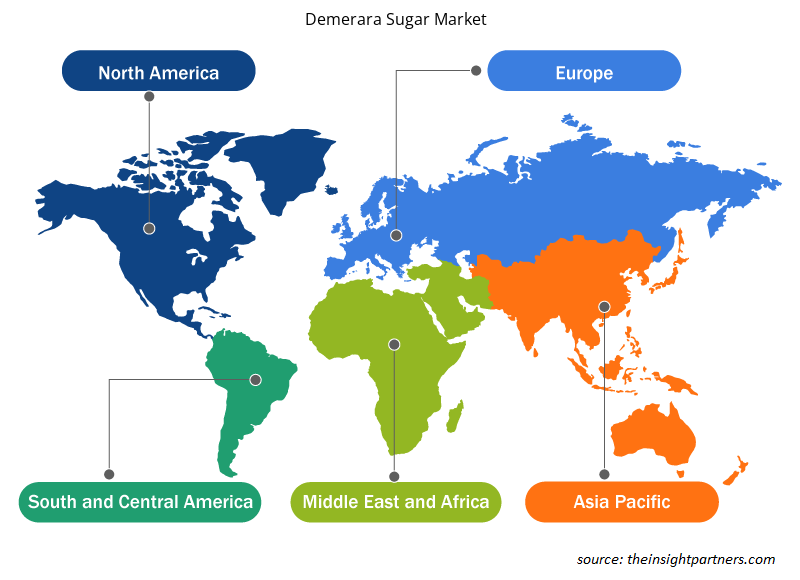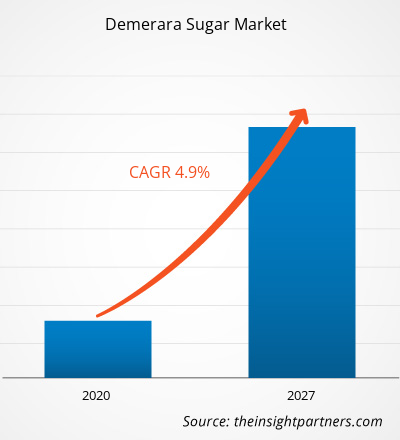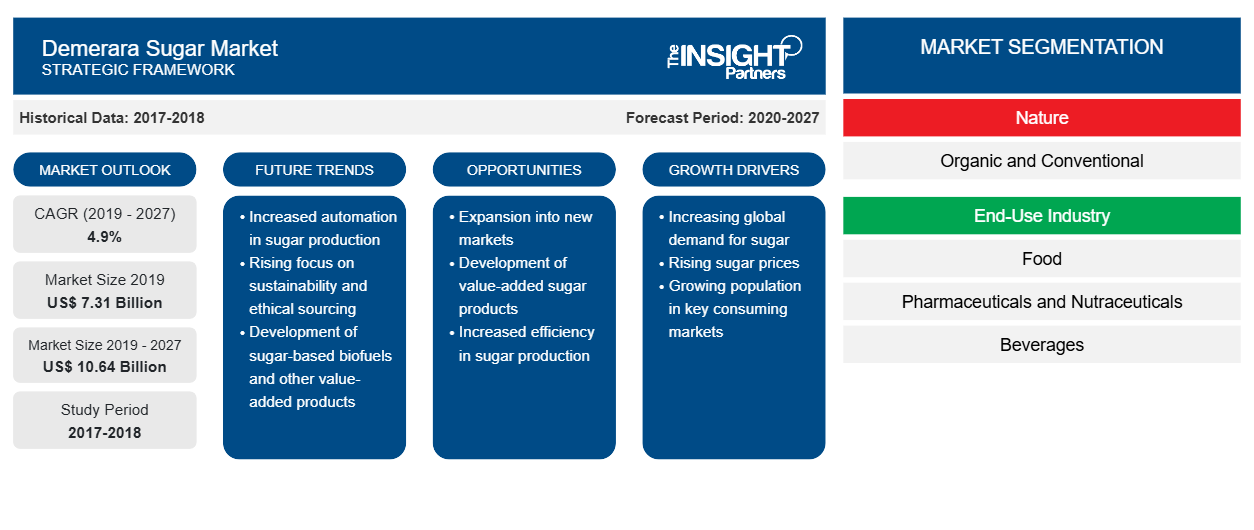Nel 2019 il mercato dello zucchero Demerara era valutato 7.305,88 milioni di dollari USA e si prevede che raggiungerà i 10.635,27 milioni di dollari USA entro il 2027; si prevede una crescita a un CAGR del 4,9% dal 2020 al 2027.
Lo zucchero Demerara è ricavato dalla canna da zucchero e comprende grandi grani che forniscono una consistenza dolce e croccante nella cottura al forno e in altre applicazioni. È utilizzato principalmente come granella per decorare torte e muffin. Può anche essere aggiunto al caffè e al tè. Una piccola quantità di melassa si trova naturalmente nello zucchero Demerara, che gli conferisce un colore marrone chiaro e un sapore di caramello. Lo zucchero Demerara contiene un contenuto di saccarosio significativamente inferiore (88-93%) rispetto allo zucchero bianco (96-98%). Nello zucchero Demerara si trovano minerali vitali come manganese, magnesio, zinco, cromo e cobalto. Lo zucchero Demerara proviene dalla Guyana, Sud America, e la maggior parte dello zucchero Demerara disponibile oggi proviene da Mauritius in Africa. Inoltre, le crescenti applicazioni dello zucchero Demerara nel settore alimentare offrono opportunità redditizie per i principali attori del mercato.
Si prevede che il mercato globale dello zucchero demerara nell'area Asia-Pacifico crescerà al CAGR più alto del 5,2% nel periodo 2020-2027. Si prevede che la crescente domanda di zucchero demerara da parte di vari settori di utilizzo finale come alimentare, farmaceutico e nutraceutico e bevande stimolerà la crescita del mercato durante il periodo di previsione.
L'epidemia di COVID-19 è stata segnalata per la prima volta a Wuhan (Cina) nel dicembre 2019. A gennaio 2021, Stati Uniti, Russia, India, Cina, Italia, Francia e Germania sono tra i paesi più colpiti in termini di casi positivi al COVID-19 e decessi segnalati. Secondo i dati dell'OMS aggiornati a gennaio 2021, sono stati segnalati circa 85.929.428 casi confermati e circa 1.876.100 decessi a livello globale. L'epidemia sta influenzando negativamente economie e settori a causa di blocchi, divieti di viaggio e chiusure aziendali imposte dai governi. Il settore alimentare e delle bevande è una delle principali industrie al mondo che sta subendo gravi interruzioni sotto forma di interruzioni della catena di fornitura, cancellazioni di eventi tecnologici e chiusure di uffici. Sebbene la Cina sia il polo manifatturiero globale e il più grande fornitore di materie prime per vari settori nel mondo, è anche uno dei paesi più colpiti dalla pandemia di COVID-19. Il blocco di vari impianti e fabbriche in Cina sta interrompendo le catene di fornitura globali, nonché le attività di produzione e le vendite di varie materie prime utilizzate nell'industria alimentare e nei prodotti finali. La chiusura delle fabbriche, gli ostacoli nelle catene di fornitura e la crisi dell'economia mondiale stanno frenando la crescita complessiva del mercato dello zucchero demerara.
Personalizza questo report in base alle tue esigenze
Riceverai la personalizzazione gratuita di qualsiasi report, comprese parti di questo report, o analisi a livello nazionale, pacchetto dati Excel, oltre a usufruire di grandi offerte e sconti per start-up e università
-
Scopri le principali tendenze di mercato in questo rapporto.Questo campione GRATUITO includerà analisi di dati che spaziano dalle tendenze di mercato alle stime e alle previsioni.
Approfondimenti di mercato
Le crescenti applicazioni dello zucchero Demerara nelle applicazioni di panificazione guidano la crescita del mercato
Lo zucchero Demerara è un tipo di zucchero di canna grezzo minimamente lavorato. È disponibile sotto forma di grandi grani di colore ambrato ed è utilizzato principalmente come ingrediente di guarnizione. Nell'industria della panificazione, lo zucchero Demerara è ampiamente utilizzato come guarnizione per prodotti da forno come muffin, scones, biscotti, torte e anche per crumble. Lo zucchero Demerara ha un leggero sapore di melassa che lo rende più delizioso del normale zucchero bianco. Mantiene i prodotti da forno morbidi e umidi. La miscela di zucchero e acqua aiuta lo zucchero a trattenere l'umidità in modo che prodotti come biscotti, muffin, brownies e frosting non si secchino troppo facilmente. Produce tenerezza, intensifica il colore e il sapore e aggiunge croccantezza. Per questo motivo, è ampiamente utilizzato nelle applicazioni di panificazione. Contiene principalmente la giusta quantità di calcio e magnesio e contiene anche vitamine B3, B5 e B6. Lo zucchero Demerara è anche noto per essere utile nel trattenere vitamine e minerali presenti in modo innato nella canna da zucchero. Inoltre, lo zucchero Demerara contiene una quantità di saccarosio sostanzialmente inferiore (88-93%) rispetto allo zucchero bianco (96-98%). La crescente consapevolezza dei benefici per la salute dello zucchero Demerara sta spingendo la domanda per la sua introduzione in varie ricette.
Approfondimenti sulla natura
In base alla natura, il mercato dello zucchero demerara è diviso in biologico e convenzionale. Il segmento convenzionale ha rappresentato una quota di mercato maggiore nel 2019; mentre, si prevede che il mercato dello zucchero demerara biologico crescerà a un CAGR più elevato durante il periodo di previsione. La forma convenzionale di tecnica agricola è ampiamente adottata tra gli agricoltori per ottenere una resa maggiore e una maggiore disponibilità di prodotto a basso costo. La tecnica è a favore dei produttori e dei coltivatori poiché le rese sono elevate rispetto ai costi. Inoltre, la mancanza di conoscenza tra gli agricoltori sui benefici per la salute associati all'agricoltura biologica ha promosso la crescita del segmento. Ad esempio, nel 2017, quasi il 63% degli agricoltori ha adottato l'agricoltura convenzionale per produrre zucchero demerara e il 37% di loro ha optato per l'agricoltura biologica in Turchia. Tuttavia, ci sono diversi svantaggi correlati a questo metodo. Lo zucchero demerara prodotto con metodo convenzionale può contenere meno nutrienti. L'agricoltura convenzionale è uno dei metodi agricoli più praticati che prevede l'uso di fertilizzanti, pesticidi e altri composti chimici. Inoltre, comporta rischi per la salute e l'ambiente poiché comporta il rilascio di sostanze inquinanti nell'ambiente.
Approfondimenti sul settore dell'uso finale
In base al settore di utilizzo finale, il mercato dello zucchero demerara è suddiviso in alimenti, prodotti farmaceutici e nutraceutici, bevande e altri. Il segmento alimentare ha rappresentato la quota maggiore del mercato nel 2019 e si prevede che l'altro segmento registrerà il CAGR più elevato nel periodo 2020-2027. Lo zucchero demerara ha una consistenza croccante e una grande forma di cristalli dorati scintillanti. I grandi cristalli significano che mantiene la sua forma durante la cottura. È perfetto per la spolverata e può anche essere utilizzato per la cottura al forno, specialmente in articoli come basi per cheesecake, crumble, flapjack e biscotti che necessitano di croccantezza extra. Lo zucchero demerara è uno zucchero di canna grezzo non raffinato con grandi cristalli color caramello. Sono utilizzati principalmente per offrire la consistenza desiderata nelle torte, in una copertura streusel per una torta, in un crumble o come guarnizione croccante per biscotti.
Informazioni sui canali di distribuzione
In base al canale di distribuzione, il mercato dello zucchero demerara è suddiviso in negozi di alimentari, supermercati o ipermercati, distributori e grossisti, rivenditori online e altri. Il segmento distributori e grossisti ha rappresentato la quota maggiore del mercato nel 2019, mentre si prevede che il segmento dei rivenditori online registrerà il CAGR più elevato durante il periodo di previsione. L'azienda nomina un distributore per vendere il prodotto per suo conto. I rivenditori online sono i mediatori tra i produttori/fabbricanti e i rivenditori. Vendono e promuovono il prodotto per conto dei produttori alle parti interessate. Inoltre, un grossista opera come mediatore tra il rivenditore e il distributore. Queste persone acquistano un prodotto in quantità sostanziale dal produttore o dal distributore a una tariffa più economica e lo rivendono ai rivenditori a un prezzo più alto per realizzare un profitto. I distributori trovano grossisti che rivenderanno i prodotti. Un grossista lavora più a stretto contatto con i rivenditori per soddisfare le loro esigenze acquistando prodotti all'ingrosso a un prezzo scontato. Un distributore è attivamente coinvolto nella promozione dei prodotti di un'azienda, un grossista no. I prodotti acquistati dai negozi preferiti spesso implicano una distribuzione da una varietà di fonti. Portare un prodotto sul mercato richiede principalmente un canale di marketing efficace per le aziende che producono beni durevoli e altri prodotti. Una catena di fornitura in genere presenta vari intermediari tra un produttore e un consumatore.
Fusioni e acquisizioni, lancio di prodotti e ricerca e sviluppo sono strategie comunemente adottate dalle aziende per espandere la propria presenza in tutto il mondo, il che sta ulteriormente influenzando positivamente le dimensioni del mercato dello zucchero demerara. I player che operano nel mercato come Ragus Sugars Manufacturing Limited, Tate & Lyle e altri hanno implementato queste strategie per ampliare la base clienti, ottenere una quota di mercato significativa e mantenere il proprio marchio a livello globale. Ad esempio, a luglio 2017, Tate & Lyle ha lanciato la sua nuova gamma di prodotti premium di zucchero bruno e dorato chiamata Taste for Adventure. La gamma di prodotti include un mix di cinque zuccheri bruno e dorati biologici premium come Dark Soft Brown, Organic Dark Soft Brown, Golden Caster, Organic Golden Caster e Demerara.
Approfondimenti regionali sul mercato dello zucchero Demerara
Le tendenze regionali e i fattori che influenzano il mercato dello zucchero Demerara durante il periodo di previsione sono stati ampiamente spiegati dagli analisti di Insight Partners. Questa sezione discute anche i segmenti e la geografia del mercato dello zucchero Demerara in Nord America, Europa, Asia Pacifico, Medio Oriente e Africa e America meridionale e centrale.

- Ottieni i dati specifici regionali per il mercato dello zucchero Demerara
Ambito del rapporto sul mercato dello zucchero Demerara
| Attributo del report | Dettagli |
|---|---|
| Dimensioni del mercato nel 2019 | 7,31 miliardi di dollari USA |
| Dimensioni del mercato entro il 2027 | 10,64 miliardi di dollari USA |
| CAGR globale (2019 - 2027) | 4,9% |
| Dati storici | 2017-2018 |
| Periodo di previsione | 2020-2027 |
| Segmenti coperti |
Per natura
|
| Regioni e Paesi coperti |
America del Nord
|
| Leader di mercato e profili aziendali chiave |
|
Densità degli operatori del mercato dello zucchero Demerara: comprendere il suo impatto sulle dinamiche aziendali
Il mercato dello zucchero Demerara sta crescendo rapidamente, spinto dalla crescente domanda degli utenti finali dovuta a fattori quali l'evoluzione delle preferenze dei consumatori, i progressi tecnologici e una maggiore consapevolezza dei benefici del prodotto. Con l'aumento della domanda, le aziende stanno ampliando le loro offerte, innovando per soddisfare le esigenze dei consumatori e capitalizzando sulle tendenze emergenti, il che alimenta ulteriormente la crescita del mercato.
La densità degli operatori di mercato si riferisce alla distribuzione di aziende o società che operano in un particolare mercato o settore. Indica quanti concorrenti (operatori di mercato) sono presenti in un dato spazio di mercato in relazione alle sue dimensioni o al valore di mercato totale.
Le principali aziende che operano nel mercato dello zucchero Demerara sono:
- Società per azioni Guyana Sugar Corporation Inc.
- Società controllata da Associated British Foods plc.
- Gruppo Tereos
- Industrie LOC
- Nordzucker AG
Disclaimer : le aziende elencate sopra non sono classificate secondo un ordine particolare.

- Ottieni una panoramica dei principali attori del mercato dello zucchero Demerara
Segnala i riflettori
- Tendenze industriali progressive nel mercato globale dello zucchero demerara che aiutano gli operatori a sviluppare strategie efficaci a lungo termine
- Strategie di crescita aziendale adottate dai mercati sviluppati e in via di sviluppo
- Analisi quantitativa del mercato dal 2017 al 2027
- Stima della domanda globale di zucchero demerara nei vari settori
- Analisi PEST per illustrare l'efficacia degli acquirenti e dei fornitori che operano nel settore per prevedere la crescita del mercato
- Sviluppi recenti per comprendere lo scenario competitivo del mercato e la domanda globale di zucchero demerara
- Tendenze e prospettive del mercato e fattori che guidano e frenano la crescita del mercato dello zucchero demerara
- Comprensione delle strategie che sostengono l'interesse commerciale in relazione alla crescita del mercato, il che facilita un processo decisionale efficace
- Dimensioni del mercato dello zucchero Demerara nei vari nodi del mercato
- Panoramica dettagliata e segmentazione del mercato, nonché dinamiche del settore
- Dimensioni del mercato globale dello zucchero demerara in varie regioni con promettenti opportunità di crescita in queste regioni
Mercato dello zucchero Demerara, per natura
- Organico
- Convenzionale
Mercato dello zucchero Demerara, per settore di utilizzo finale
- Cibo
- Prodotti farmaceutici e nutraceutici
- Bevande
- Altri
Mercato dello zucchero Demerara, per canale di distribuzione
- Negozi di alimentari
- Supermercati o ipermercati
- Distributori e grossisti
- Rivenditori online
- Altri
Profili aziendali
- Società per azioni Guyana Sugar Corporation Inc.
- Società controllata da Associated British Foods plc.
- Gruppo Tereos
- Industrie LOC
- Nordzucker AG
- Ragus Sugars Manufacturing Limited
- Società di zucchero australiana Ltd
- Tate e Lyle
- Alteo limitata
- Rajshree Zuccheri e Prodotti Chimici Ltd
- Analisi storica (2 anni), anno base, previsione (7 anni) con CAGR
- Analisi PEST e SWOT
- Valore/volume delle dimensioni del mercato - Globale, Regionale, Nazionale
- Industria e panorama competitivo
- Set di dati Excel
Report recenti
Rapporti correlati
Testimonianze
Motivo dell'acquisto
- Processo decisionale informato
- Comprensione delle dinamiche di mercato
- Analisi competitiva
- Analisi dei clienti
- Previsioni di mercato
- Mitigazione del rischio
- Pianificazione strategica
- Giustificazione degli investimenti
- Identificazione dei mercati emergenti
- Miglioramento delle strategie di marketing
- Aumento dell'efficienza operativa
- Allineamento alle tendenze normative























 Ottieni un campione gratuito per - Mercato dello zucchero Demerara
Ottieni un campione gratuito per - Mercato dello zucchero Demerara